Case Study: Oz Supermarket
VerifiedAdded on 2019/11/26
|11
|2820
|278
Case Study
AI Summary
This case study analyzes the challenges faced by Oz Supermarket regarding long queues at checkout counters. It examines the implementation of PayWave technology and RFID chips to streamline the payment process and reduce waiting times. The study also explores additional strategies for improving customer service, such as using infrared cameras to predict customer flow and optimize staffing levels. Furthermore, it emphasizes the importance of gathering customer feedback to enhance operational efficiency, personalize services, and improve product quality. The use of video-driven business intelligence systems to monitor customer experience and optimize store operations is also discussed. The case study provides recommendations for improving customer service and overall business operations at Oz Supermarket.
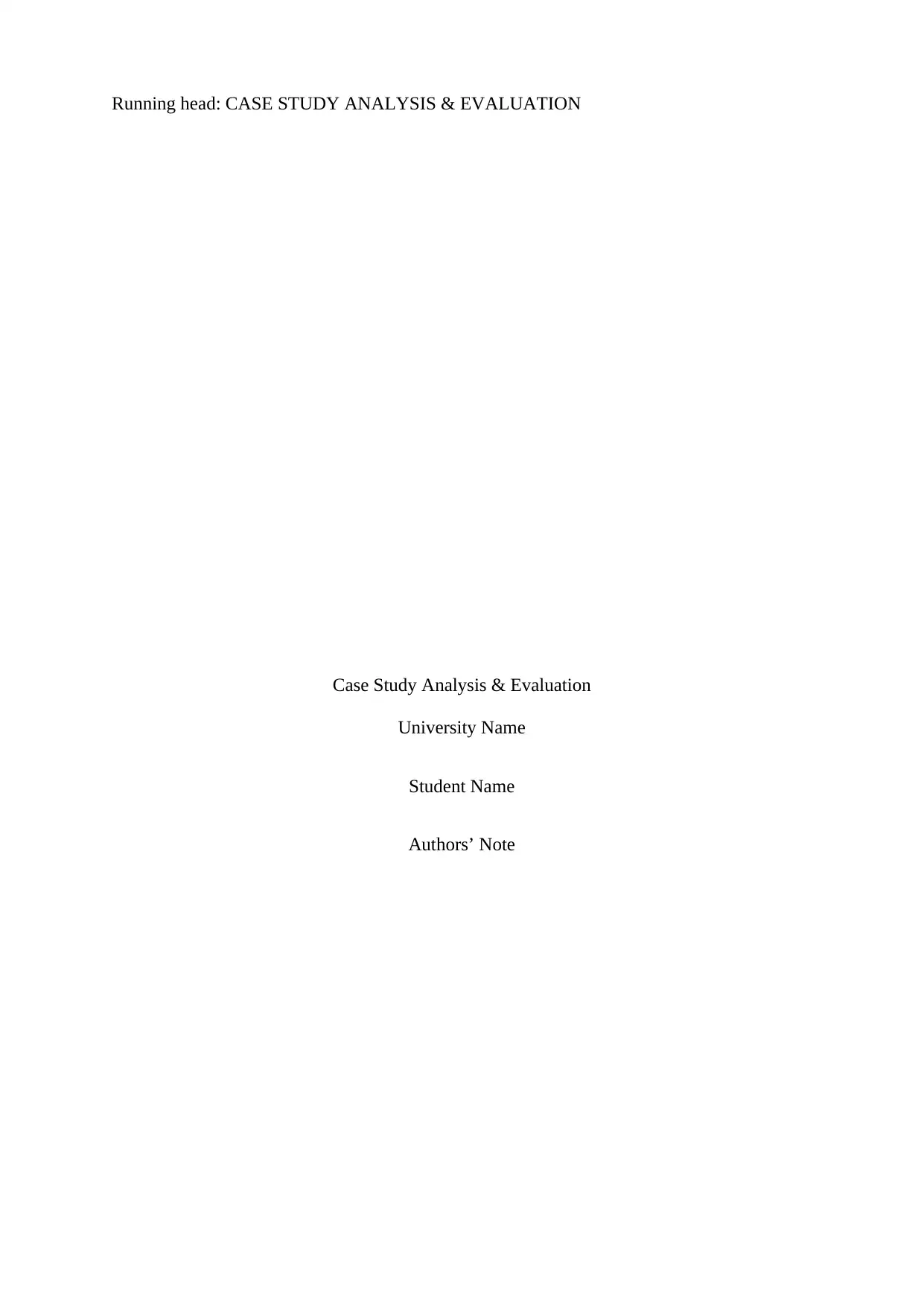
Running head: CASE STUDY ANALYSIS & EVALUATION
Case Study Analysis & Evaluation
University Name
Student Name
Authors’ Note
Case Study Analysis & Evaluation
University Name
Student Name
Authors’ Note
Paraphrase This Document
Need a fresh take? Get an instant paraphrase of this document with our AI Paraphraser

2
CASE STUDY ANALYSIS & EVALUATION
Table of Contents
Solution to Question 1:...............................................................................................................2
Solution to Question 2:...............................................................................................................5
References..................................................................................................................................9
CASE STUDY ANALYSIS & EVALUATION
Table of Contents
Solution to Question 1:...............................................................................................................2
Solution to Question 2:...............................................................................................................5
References..................................................................................................................................9
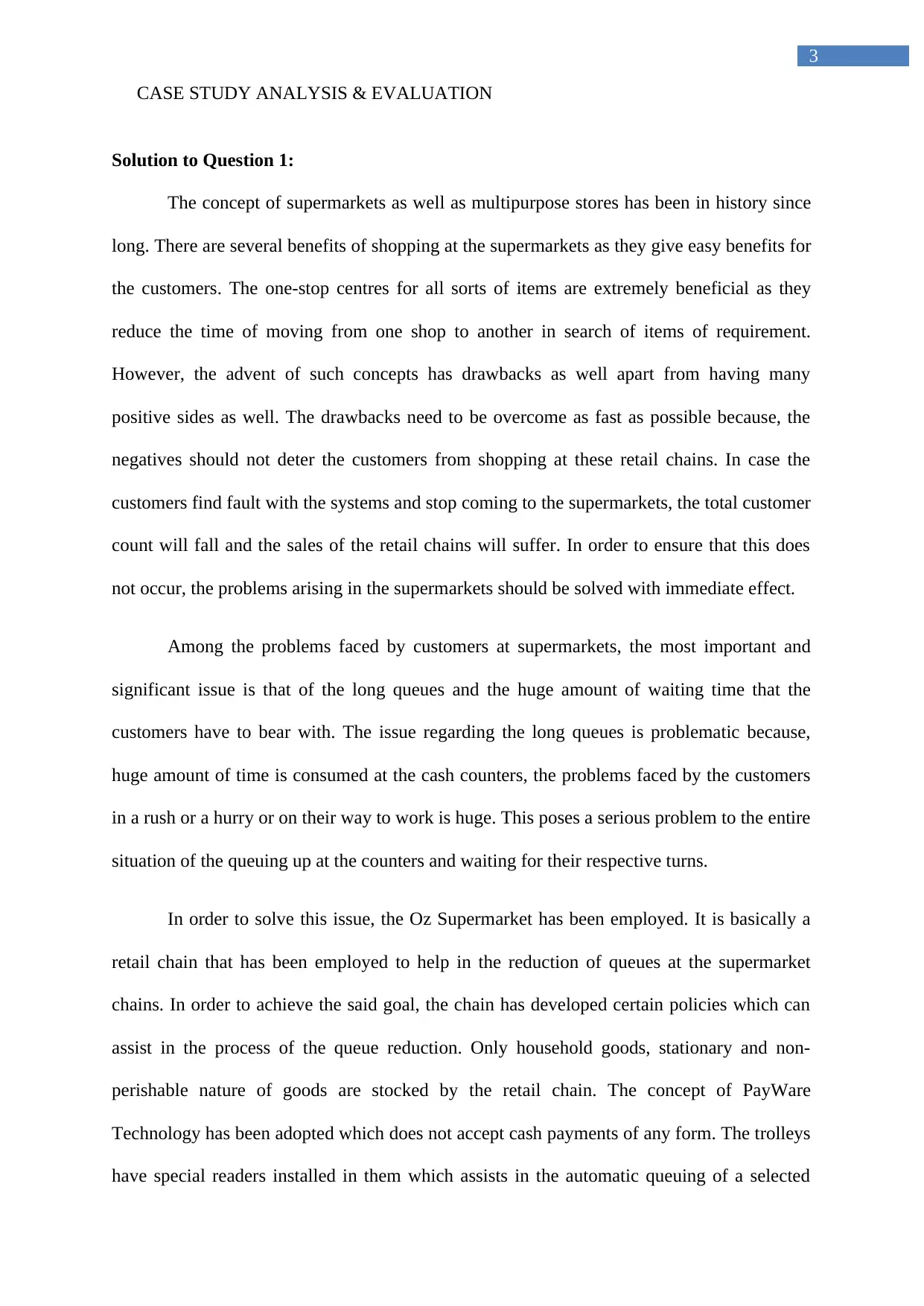
3
CASE STUDY ANALYSIS & EVALUATION
Solution to Question 1:
The concept of supermarkets as well as multipurpose stores has been in history since
long. There are several benefits of shopping at the supermarkets as they give easy benefits for
the customers. The one-stop centres for all sorts of items are extremely beneficial as they
reduce the time of moving from one shop to another in search of items of requirement.
However, the advent of such concepts has drawbacks as well apart from having many
positive sides as well. The drawbacks need to be overcome as fast as possible because, the
negatives should not deter the customers from shopping at these retail chains. In case the
customers find fault with the systems and stop coming to the supermarkets, the total customer
count will fall and the sales of the retail chains will suffer. In order to ensure that this does
not occur, the problems arising in the supermarkets should be solved with immediate effect.
Among the problems faced by customers at supermarkets, the most important and
significant issue is that of the long queues and the huge amount of waiting time that the
customers have to bear with. The issue regarding the long queues is problematic because,
huge amount of time is consumed at the cash counters, the problems faced by the customers
in a rush or a hurry or on their way to work is huge. This poses a serious problem to the entire
situation of the queuing up at the counters and waiting for their respective turns.
In order to solve this issue, the Oz Supermarket has been employed. It is basically a
retail chain that has been employed to help in the reduction of queues at the supermarket
chains. In order to achieve the said goal, the chain has developed certain policies which can
assist in the process of the queue reduction. Only household goods, stationary and non-
perishable nature of goods are stocked by the retail chain. The concept of PayWare
Technology has been adopted which does not accept cash payments of any form. The trolleys
have special readers installed in them which assists in the automatic queuing of a selected
CASE STUDY ANALYSIS & EVALUATION
Solution to Question 1:
The concept of supermarkets as well as multipurpose stores has been in history since
long. There are several benefits of shopping at the supermarkets as they give easy benefits for
the customers. The one-stop centres for all sorts of items are extremely beneficial as they
reduce the time of moving from one shop to another in search of items of requirement.
However, the advent of such concepts has drawbacks as well apart from having many
positive sides as well. The drawbacks need to be overcome as fast as possible because, the
negatives should not deter the customers from shopping at these retail chains. In case the
customers find fault with the systems and stop coming to the supermarkets, the total customer
count will fall and the sales of the retail chains will suffer. In order to ensure that this does
not occur, the problems arising in the supermarkets should be solved with immediate effect.
Among the problems faced by customers at supermarkets, the most important and
significant issue is that of the long queues and the huge amount of waiting time that the
customers have to bear with. The issue regarding the long queues is problematic because,
huge amount of time is consumed at the cash counters, the problems faced by the customers
in a rush or a hurry or on their way to work is huge. This poses a serious problem to the entire
situation of the queuing up at the counters and waiting for their respective turns.
In order to solve this issue, the Oz Supermarket has been employed. It is basically a
retail chain that has been employed to help in the reduction of queues at the supermarket
chains. In order to achieve the said goal, the chain has developed certain policies which can
assist in the process of the queue reduction. Only household goods, stationary and non-
perishable nature of goods are stocked by the retail chain. The concept of PayWare
Technology has been adopted which does not accept cash payments of any form. The trolleys
have special readers installed in them which assists in the automatic queuing of a selected
⊘ This is a preview!⊘
Do you want full access?
Subscribe today to unlock all pages.

Trusted by 1+ million students worldwide
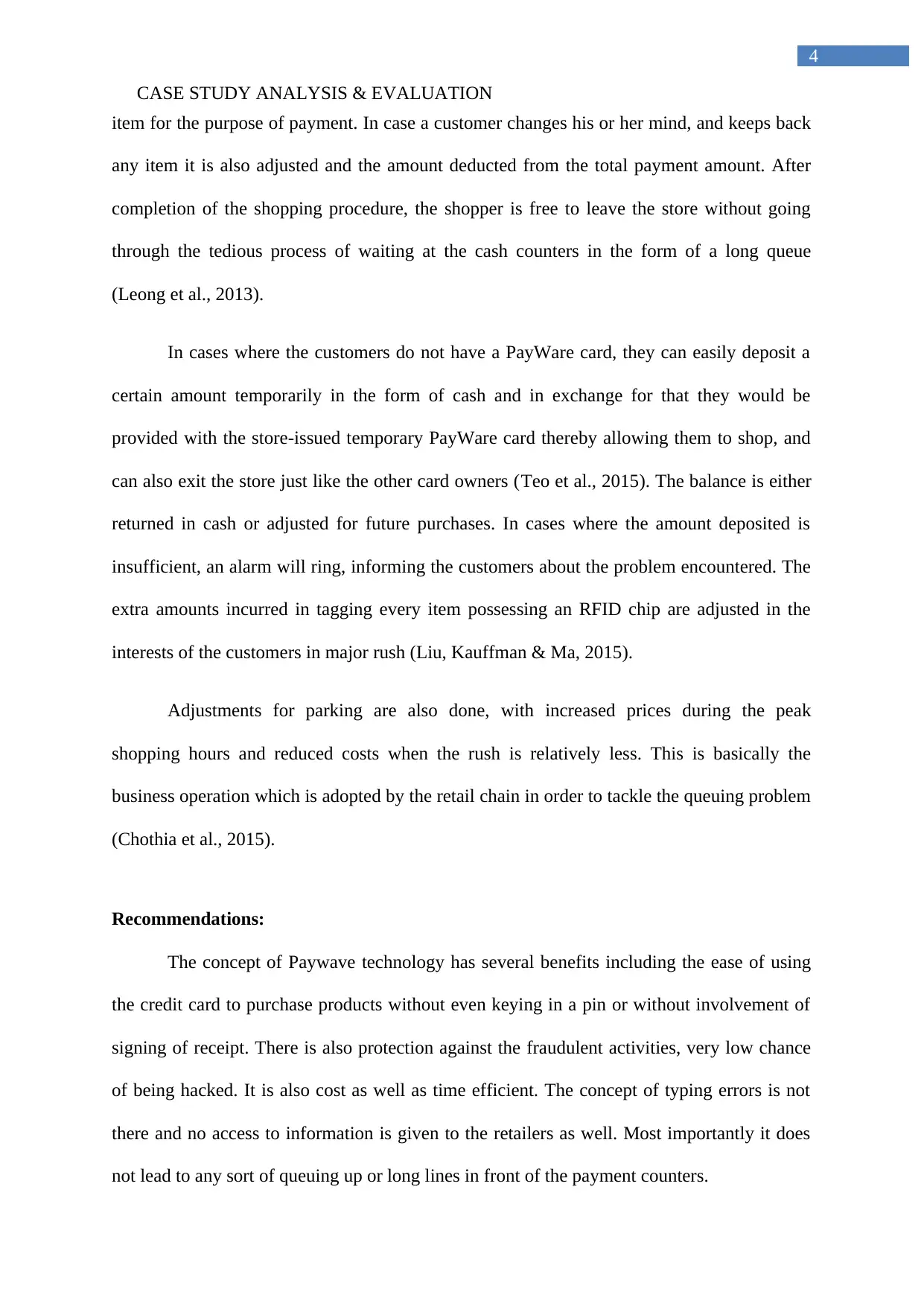
4
CASE STUDY ANALYSIS & EVALUATION
item for the purpose of payment. In case a customer changes his or her mind, and keeps back
any item it is also adjusted and the amount deducted from the total payment amount. After
completion of the shopping procedure, the shopper is free to leave the store without going
through the tedious process of waiting at the cash counters in the form of a long queue
(Leong et al., 2013).
In cases where the customers do not have a PayWare card, they can easily deposit a
certain amount temporarily in the form of cash and in exchange for that they would be
provided with the store-issued temporary PayWare card thereby allowing them to shop, and
can also exit the store just like the other card owners (Teo et al., 2015). The balance is either
returned in cash or adjusted for future purchases. In cases where the amount deposited is
insufficient, an alarm will ring, informing the customers about the problem encountered. The
extra amounts incurred in tagging every item possessing an RFID chip are adjusted in the
interests of the customers in major rush (Liu, Kauffman & Ma, 2015).
Adjustments for parking are also done, with increased prices during the peak
shopping hours and reduced costs when the rush is relatively less. This is basically the
business operation which is adopted by the retail chain in order to tackle the queuing problem
(Chothia et al., 2015).
Recommendations:
The concept of Paywave technology has several benefits including the ease of using
the credit card to purchase products without even keying in a pin or without involvement of
signing of receipt. There is also protection against the fraudulent activities, very low chance
of being hacked. It is also cost as well as time efficient. The concept of typing errors is not
there and no access to information is given to the retailers as well. Most importantly it does
not lead to any sort of queuing up or long lines in front of the payment counters.
CASE STUDY ANALYSIS & EVALUATION
item for the purpose of payment. In case a customer changes his or her mind, and keeps back
any item it is also adjusted and the amount deducted from the total payment amount. After
completion of the shopping procedure, the shopper is free to leave the store without going
through the tedious process of waiting at the cash counters in the form of a long queue
(Leong et al., 2013).
In cases where the customers do not have a PayWare card, they can easily deposit a
certain amount temporarily in the form of cash and in exchange for that they would be
provided with the store-issued temporary PayWare card thereby allowing them to shop, and
can also exit the store just like the other card owners (Teo et al., 2015). The balance is either
returned in cash or adjusted for future purchases. In cases where the amount deposited is
insufficient, an alarm will ring, informing the customers about the problem encountered. The
extra amounts incurred in tagging every item possessing an RFID chip are adjusted in the
interests of the customers in major rush (Liu, Kauffman & Ma, 2015).
Adjustments for parking are also done, with increased prices during the peak
shopping hours and reduced costs when the rush is relatively less. This is basically the
business operation which is adopted by the retail chain in order to tackle the queuing problem
(Chothia et al., 2015).
Recommendations:
The concept of Paywave technology has several benefits including the ease of using
the credit card to purchase products without even keying in a pin or without involvement of
signing of receipt. There is also protection against the fraudulent activities, very low chance
of being hacked. It is also cost as well as time efficient. The concept of typing errors is not
there and no access to information is given to the retailers as well. Most importantly it does
not lead to any sort of queuing up or long lines in front of the payment counters.
Paraphrase This Document
Need a fresh take? Get an instant paraphrase of this document with our AI Paraphraser
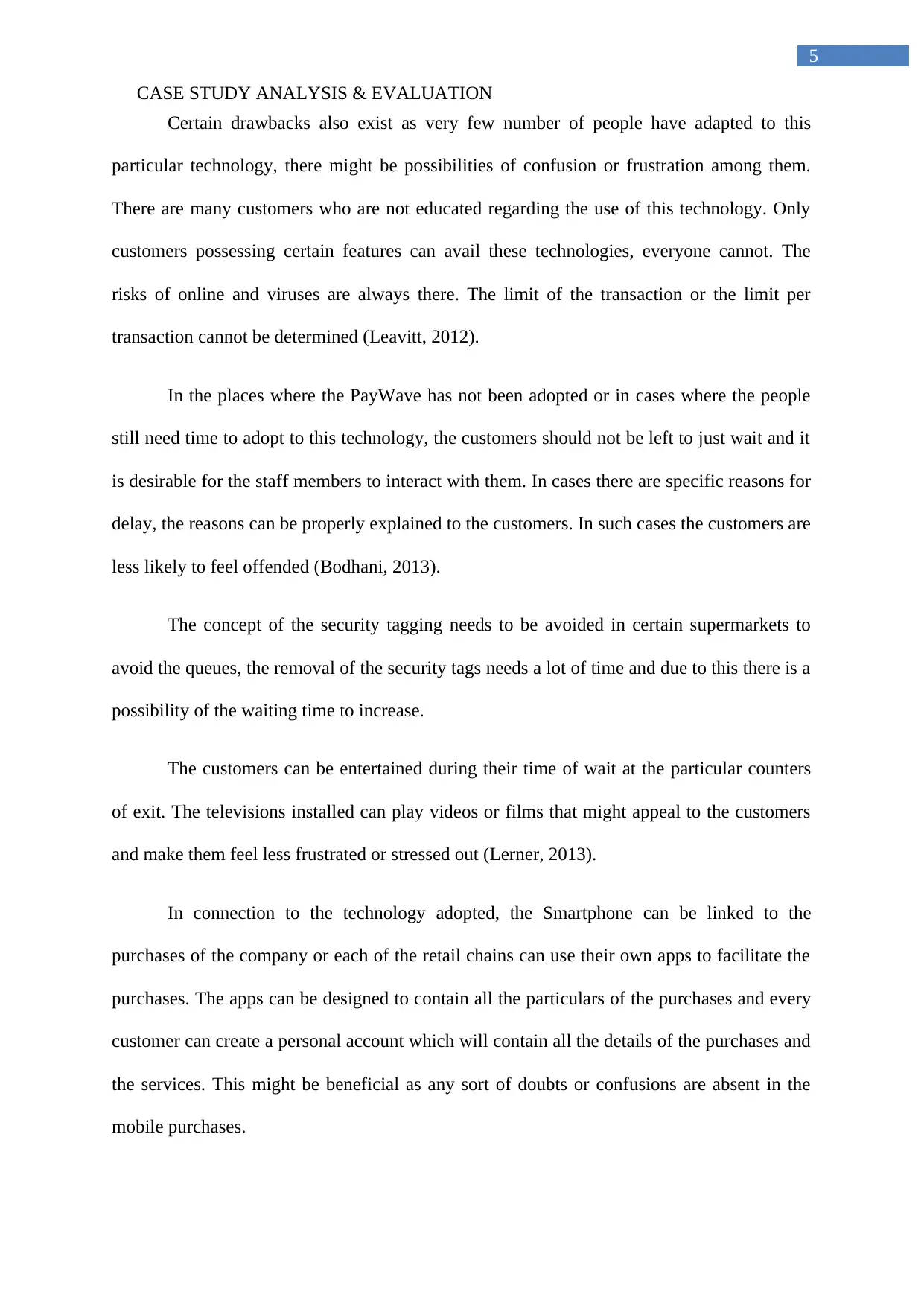
5
CASE STUDY ANALYSIS & EVALUATION
Certain drawbacks also exist as very few number of people have adapted to this
particular technology, there might be possibilities of confusion or frustration among them.
There are many customers who are not educated regarding the use of this technology. Only
customers possessing certain features can avail these technologies, everyone cannot. The
risks of online and viruses are always there. The limit of the transaction or the limit per
transaction cannot be determined (Leavitt, 2012).
In the places where the PayWave has not been adopted or in cases where the people
still need time to adopt to this technology, the customers should not be left to just wait and it
is desirable for the staff members to interact with them. In cases there are specific reasons for
delay, the reasons can be properly explained to the customers. In such cases the customers are
less likely to feel offended (Bodhani, 2013).
The concept of the security tagging needs to be avoided in certain supermarkets to
avoid the queues, the removal of the security tags needs a lot of time and due to this there is a
possibility of the waiting time to increase.
The customers can be entertained during their time of wait at the particular counters
of exit. The televisions installed can play videos or films that might appeal to the customers
and make them feel less frustrated or stressed out (Lerner, 2013).
In connection to the technology adopted, the Smartphone can be linked to the
purchases of the company or each of the retail chains can use their own apps to facilitate the
purchases. The apps can be designed to contain all the particulars of the purchases and every
customer can create a personal account which will contain all the details of the purchases and
the services. This might be beneficial as any sort of doubts or confusions are absent in the
mobile purchases.
CASE STUDY ANALYSIS & EVALUATION
Certain drawbacks also exist as very few number of people have adapted to this
particular technology, there might be possibilities of confusion or frustration among them.
There are many customers who are not educated regarding the use of this technology. Only
customers possessing certain features can avail these technologies, everyone cannot. The
risks of online and viruses are always there. The limit of the transaction or the limit per
transaction cannot be determined (Leavitt, 2012).
In the places where the PayWave has not been adopted or in cases where the people
still need time to adopt to this technology, the customers should not be left to just wait and it
is desirable for the staff members to interact with them. In cases there are specific reasons for
delay, the reasons can be properly explained to the customers. In such cases the customers are
less likely to feel offended (Bodhani, 2013).
The concept of the security tagging needs to be avoided in certain supermarkets to
avoid the queues, the removal of the security tags needs a lot of time and due to this there is a
possibility of the waiting time to increase.
The customers can be entertained during their time of wait at the particular counters
of exit. The televisions installed can play videos or films that might appeal to the customers
and make them feel less frustrated or stressed out (Lerner, 2013).
In connection to the technology adopted, the Smartphone can be linked to the
purchases of the company or each of the retail chains can use their own apps to facilitate the
purchases. The apps can be designed to contain all the particulars of the purchases and every
customer can create a personal account which will contain all the details of the purchases and
the services. This might be beneficial as any sort of doubts or confusions are absent in the
mobile purchases.
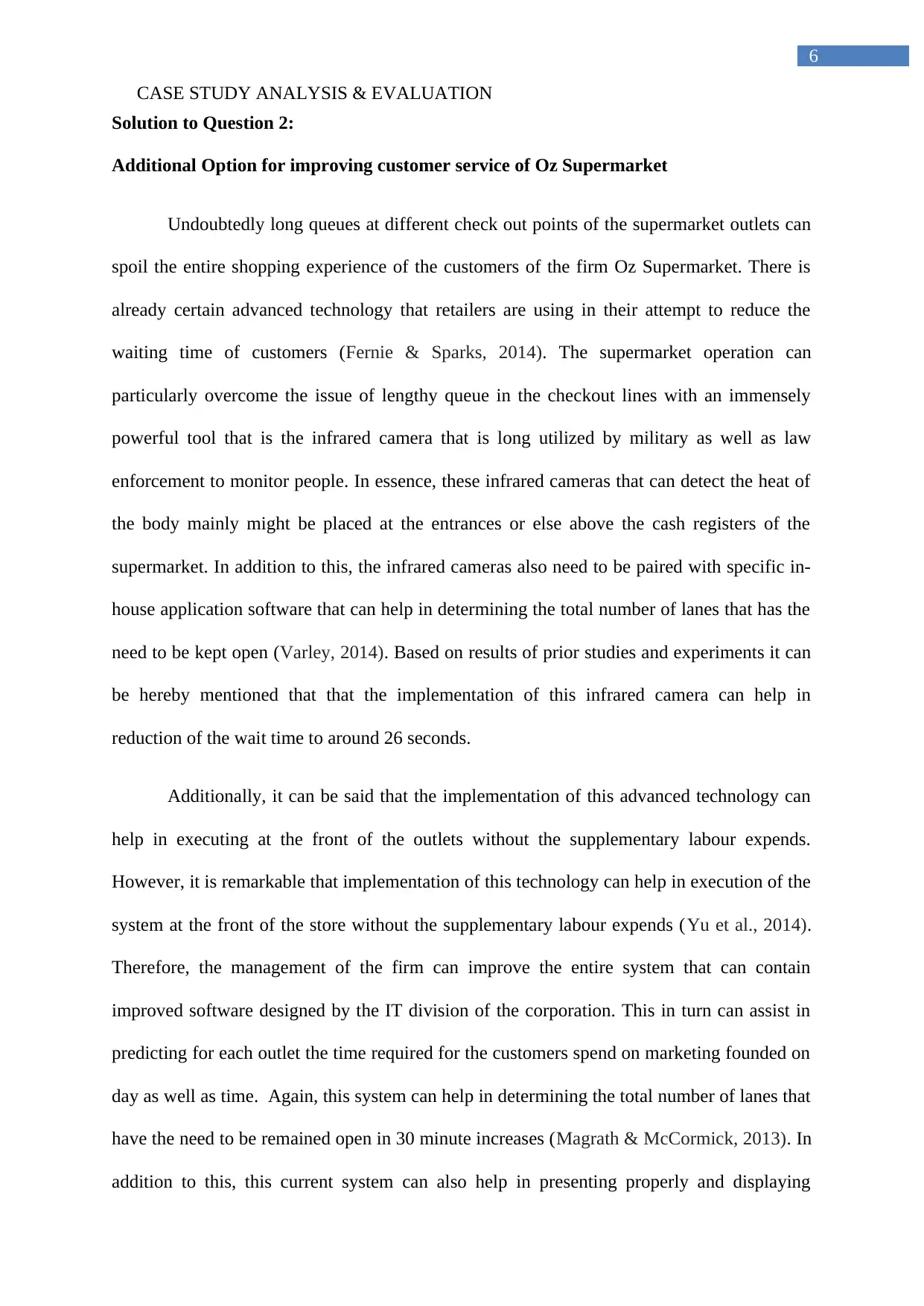
6
CASE STUDY ANALYSIS & EVALUATION
Solution to Question 2:
Additional Option for improving customer service of Oz Supermarket
Undoubtedly long queues at different check out points of the supermarket outlets can
spoil the entire shopping experience of the customers of the firm Oz Supermarket. There is
already certain advanced technology that retailers are using in their attempt to reduce the
waiting time of customers (Fernie & Sparks, 2014). The supermarket operation can
particularly overcome the issue of lengthy queue in the checkout lines with an immensely
powerful tool that is the infrared camera that is long utilized by military as well as law
enforcement to monitor people. In essence, these infrared cameras that can detect the heat of
the body mainly might be placed at the entrances or else above the cash registers of the
supermarket. In addition to this, the infrared cameras also need to be paired with specific in-
house application software that can help in determining the total number of lanes that has the
need to be kept open (Varley, 2014). Based on results of prior studies and experiments it can
be hereby mentioned that that the implementation of this infrared camera can help in
reduction of the wait time to around 26 seconds.
Additionally, it can be said that the implementation of this advanced technology can
help in executing at the front of the outlets without the supplementary labour expends.
However, it is remarkable that implementation of this technology can help in execution of the
system at the front of the store without the supplementary labour expends (Yu et al., 2014).
Therefore, the management of the firm can improve the entire system that can contain
improved software designed by the IT division of the corporation. This in turn can assist in
predicting for each outlet the time required for the customers spend on marketing founded on
day as well as time. Again, this system can help in determining the total number of lanes that
have the need to be remained open in 30 minute increases (Magrath & McCormick, 2013). In
addition to this, this current system can also help in presenting properly and displaying
CASE STUDY ANALYSIS & EVALUATION
Solution to Question 2:
Additional Option for improving customer service of Oz Supermarket
Undoubtedly long queues at different check out points of the supermarket outlets can
spoil the entire shopping experience of the customers of the firm Oz Supermarket. There is
already certain advanced technology that retailers are using in their attempt to reduce the
waiting time of customers (Fernie & Sparks, 2014). The supermarket operation can
particularly overcome the issue of lengthy queue in the checkout lines with an immensely
powerful tool that is the infrared camera that is long utilized by military as well as law
enforcement to monitor people. In essence, these infrared cameras that can detect the heat of
the body mainly might be placed at the entrances or else above the cash registers of the
supermarket. In addition to this, the infrared cameras also need to be paired with specific in-
house application software that can help in determining the total number of lanes that has the
need to be kept open (Varley, 2014). Based on results of prior studies and experiments it can
be hereby mentioned that that the implementation of this infrared camera can help in
reduction of the wait time to around 26 seconds.
Additionally, it can be said that the implementation of this advanced technology can
help in executing at the front of the outlets without the supplementary labour expends.
However, it is remarkable that implementation of this technology can help in execution of the
system at the front of the store without the supplementary labour expends (Yu et al., 2014).
Therefore, the management of the firm can improve the entire system that can contain
improved software designed by the IT division of the corporation. This in turn can assist in
predicting for each outlet the time required for the customers spend on marketing founded on
day as well as time. Again, this system can help in determining the total number of lanes that
have the need to be remained open in 30 minute increases (Magrath & McCormick, 2013). In
addition to this, this current system can also help in presenting properly and displaying
⊘ This is a preview!⊘
Do you want full access?
Subscribe today to unlock all pages.

Trusted by 1+ million students worldwide
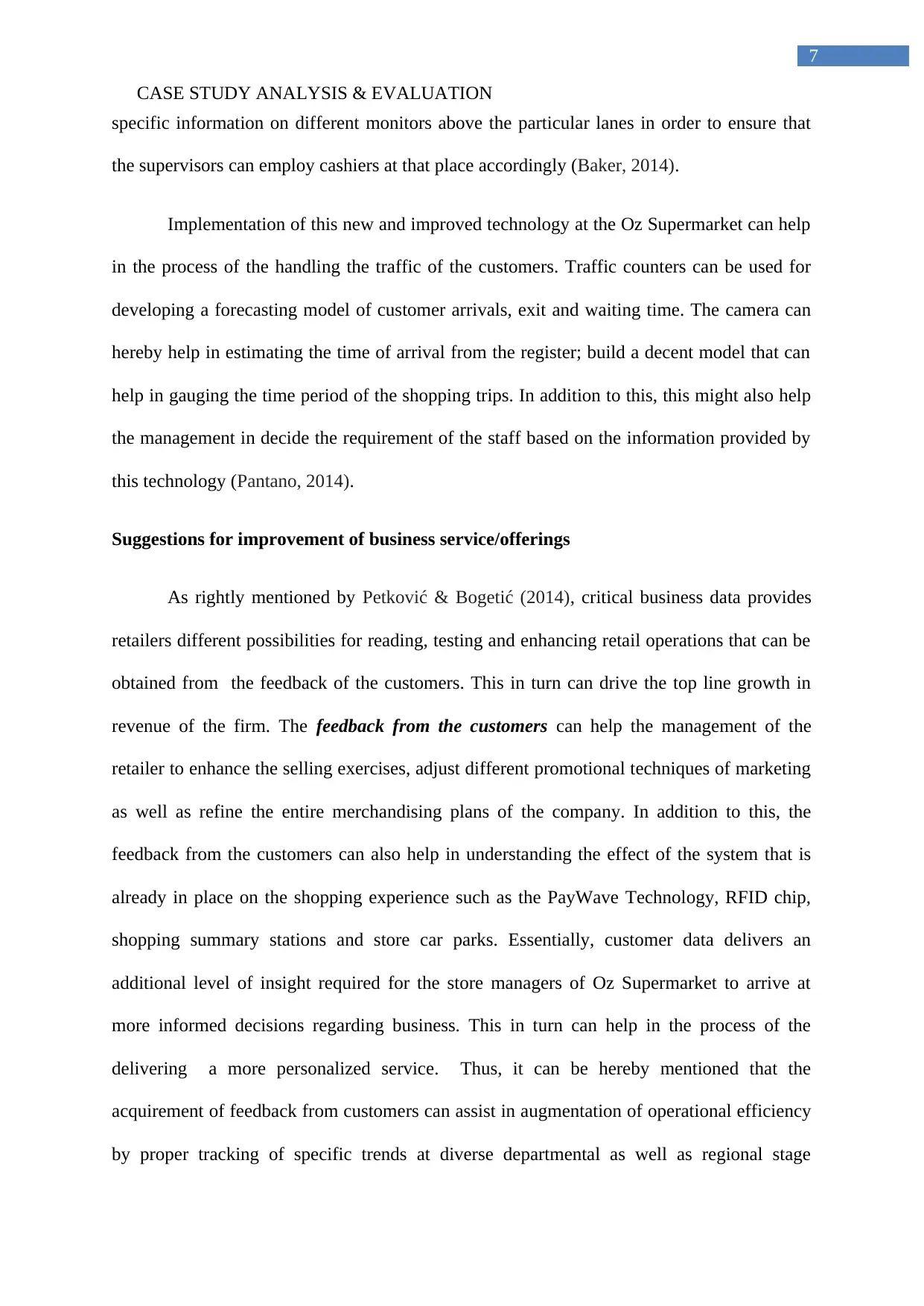
7
CASE STUDY ANALYSIS & EVALUATION
specific information on different monitors above the particular lanes in order to ensure that
the supervisors can employ cashiers at that place accordingly (Baker, 2014).
Implementation of this new and improved technology at the Oz Supermarket can help
in the process of the handling the traffic of the customers. Traffic counters can be used for
developing a forecasting model of customer arrivals, exit and waiting time. The camera can
hereby help in estimating the time of arrival from the register; build a decent model that can
help in gauging the time period of the shopping trips. In addition to this, this might also help
the management in decide the requirement of the staff based on the information provided by
this technology (Pantano, 2014).
Suggestions for improvement of business service/offerings
As rightly mentioned by Petković & Bogetić (2014), critical business data provides
retailers different possibilities for reading, testing and enhancing retail operations that can be
obtained from the feedback of the customers. This in turn can drive the top line growth in
revenue of the firm. The feedback from the customers can help the management of the
retailer to enhance the selling exercises, adjust different promotional techniques of marketing
as well as refine the entire merchandising plans of the company. In addition to this, the
feedback from the customers can also help in understanding the effect of the system that is
already in place on the shopping experience such as the PayWave Technology, RFID chip,
shopping summary stations and store car parks. Essentially, customer data delivers an
additional level of insight required for the store managers of Oz Supermarket to arrive at
more informed decisions regarding business. This in turn can help in the process of the
delivering a more personalized service. Thus, it can be hereby mentioned that the
acquirement of feedback from customers can assist in augmentation of operational efficiency
by proper tracking of specific trends at diverse departmental as well as regional stage
CASE STUDY ANALYSIS & EVALUATION
specific information on different monitors above the particular lanes in order to ensure that
the supervisors can employ cashiers at that place accordingly (Baker, 2014).
Implementation of this new and improved technology at the Oz Supermarket can help
in the process of the handling the traffic of the customers. Traffic counters can be used for
developing a forecasting model of customer arrivals, exit and waiting time. The camera can
hereby help in estimating the time of arrival from the register; build a decent model that can
help in gauging the time period of the shopping trips. In addition to this, this might also help
the management in decide the requirement of the staff based on the information provided by
this technology (Pantano, 2014).
Suggestions for improvement of business service/offerings
As rightly mentioned by Petković & Bogetić (2014), critical business data provides
retailers different possibilities for reading, testing and enhancing retail operations that can be
obtained from the feedback of the customers. This in turn can drive the top line growth in
revenue of the firm. The feedback from the customers can help the management of the
retailer to enhance the selling exercises, adjust different promotional techniques of marketing
as well as refine the entire merchandising plans of the company. In addition to this, the
feedback from the customers can also help in understanding the effect of the system that is
already in place on the shopping experience such as the PayWave Technology, RFID chip,
shopping summary stations and store car parks. Essentially, customer data delivers an
additional level of insight required for the store managers of Oz Supermarket to arrive at
more informed decisions regarding business. This in turn can help in the process of the
delivering a more personalized service. Thus, it can be hereby mentioned that the
acquirement of feedback from customers can assist in augmentation of operational efficiency
by proper tracking of specific trends at diverse departmental as well as regional stage
Paraphrase This Document
Need a fresh take? Get an instant paraphrase of this document with our AI Paraphraser
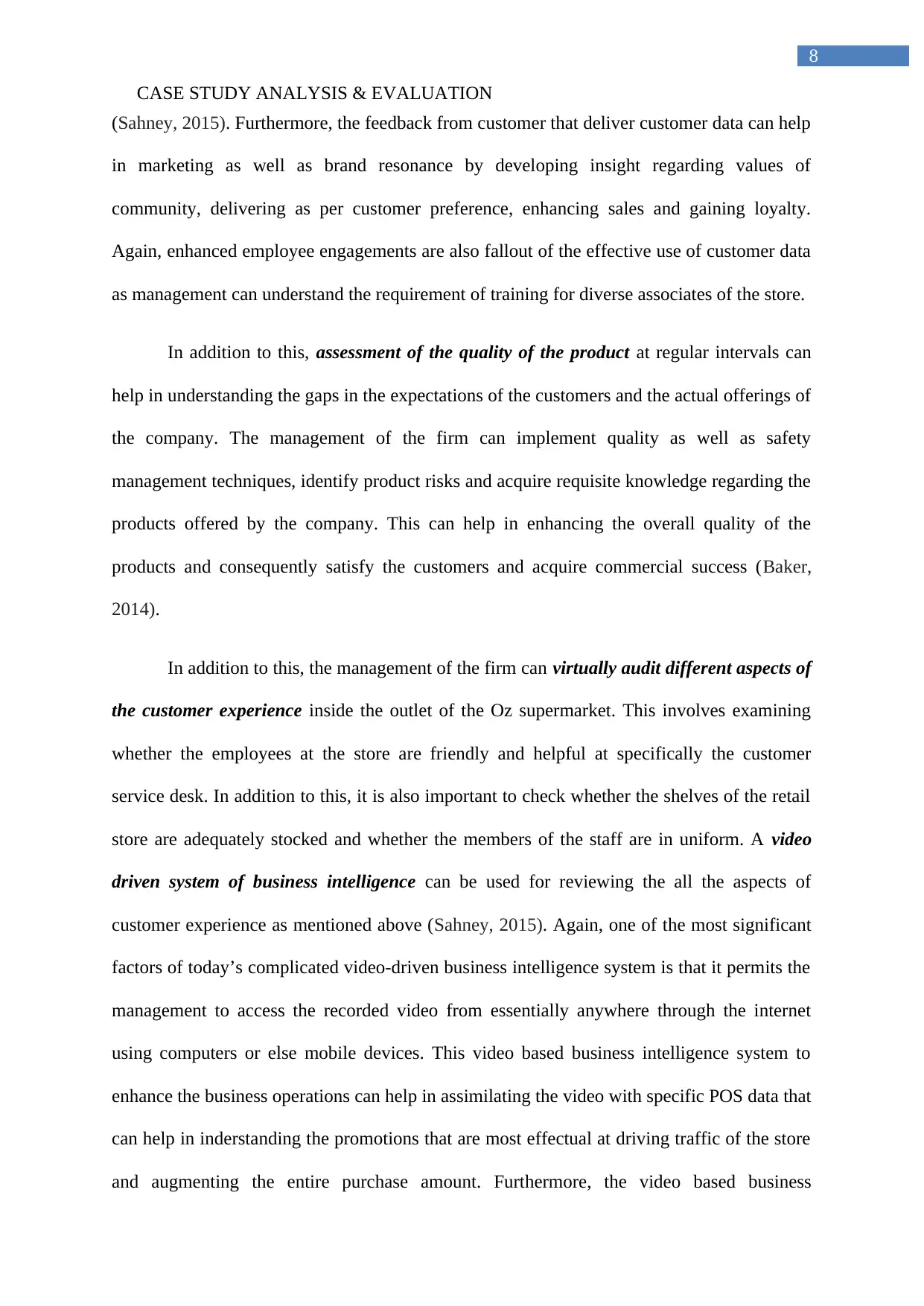
8
CASE STUDY ANALYSIS & EVALUATION
(Sahney, 2015). Furthermore, the feedback from customer that deliver customer data can help
in marketing as well as brand resonance by developing insight regarding values of
community, delivering as per customer preference, enhancing sales and gaining loyalty.
Again, enhanced employee engagements are also fallout of the effective use of customer data
as management can understand the requirement of training for diverse associates of the store.
In addition to this, assessment of the quality of the product at regular intervals can
help in understanding the gaps in the expectations of the customers and the actual offerings of
the company. The management of the firm can implement quality as well as safety
management techniques, identify product risks and acquire requisite knowledge regarding the
products offered by the company. This can help in enhancing the overall quality of the
products and consequently satisfy the customers and acquire commercial success (Baker,
2014).
In addition to this, the management of the firm can virtually audit different aspects of
the customer experience inside the outlet of the Oz supermarket. This involves examining
whether the employees at the store are friendly and helpful at specifically the customer
service desk. In addition to this, it is also important to check whether the shelves of the retail
store are adequately stocked and whether the members of the staff are in uniform. A video
driven system of business intelligence can be used for reviewing the all the aspects of
customer experience as mentioned above (Sahney, 2015). Again, one of the most significant
factors of today’s complicated video-driven business intelligence system is that it permits the
management to access the recorded video from essentially anywhere through the internet
using computers or else mobile devices. This video based business intelligence system to
enhance the business operations can help in assimilating the video with specific POS data that
can help in inderstanding the promotions that are most effectual at driving traffic of the store
and augmenting the entire purchase amount. Furthermore, the video based business
CASE STUDY ANALYSIS & EVALUATION
(Sahney, 2015). Furthermore, the feedback from customer that deliver customer data can help
in marketing as well as brand resonance by developing insight regarding values of
community, delivering as per customer preference, enhancing sales and gaining loyalty.
Again, enhanced employee engagements are also fallout of the effective use of customer data
as management can understand the requirement of training for diverse associates of the store.
In addition to this, assessment of the quality of the product at regular intervals can
help in understanding the gaps in the expectations of the customers and the actual offerings of
the company. The management of the firm can implement quality as well as safety
management techniques, identify product risks and acquire requisite knowledge regarding the
products offered by the company. This can help in enhancing the overall quality of the
products and consequently satisfy the customers and acquire commercial success (Baker,
2014).
In addition to this, the management of the firm can virtually audit different aspects of
the customer experience inside the outlet of the Oz supermarket. This involves examining
whether the employees at the store are friendly and helpful at specifically the customer
service desk. In addition to this, it is also important to check whether the shelves of the retail
store are adequately stocked and whether the members of the staff are in uniform. A video
driven system of business intelligence can be used for reviewing the all the aspects of
customer experience as mentioned above (Sahney, 2015). Again, one of the most significant
factors of today’s complicated video-driven business intelligence system is that it permits the
management to access the recorded video from essentially anywhere through the internet
using computers or else mobile devices. This video based business intelligence system to
enhance the business operations can help in assimilating the video with specific POS data that
can help in inderstanding the promotions that are most effectual at driving traffic of the store
and augmenting the entire purchase amount. Furthermore, the video based business

9
CASE STUDY ANALYSIS & EVALUATION
intelligence system can also assist in comprehending diverse store factors that in turn can
contribute towards the loyalty of the customers (Pantano, 2014).
CASE STUDY ANALYSIS & EVALUATION
intelligence system can also assist in comprehending diverse store factors that in turn can
contribute towards the loyalty of the customers (Pantano, 2014).
⊘ This is a preview!⊘
Do you want full access?
Subscribe today to unlock all pages.

Trusted by 1+ million students worldwide
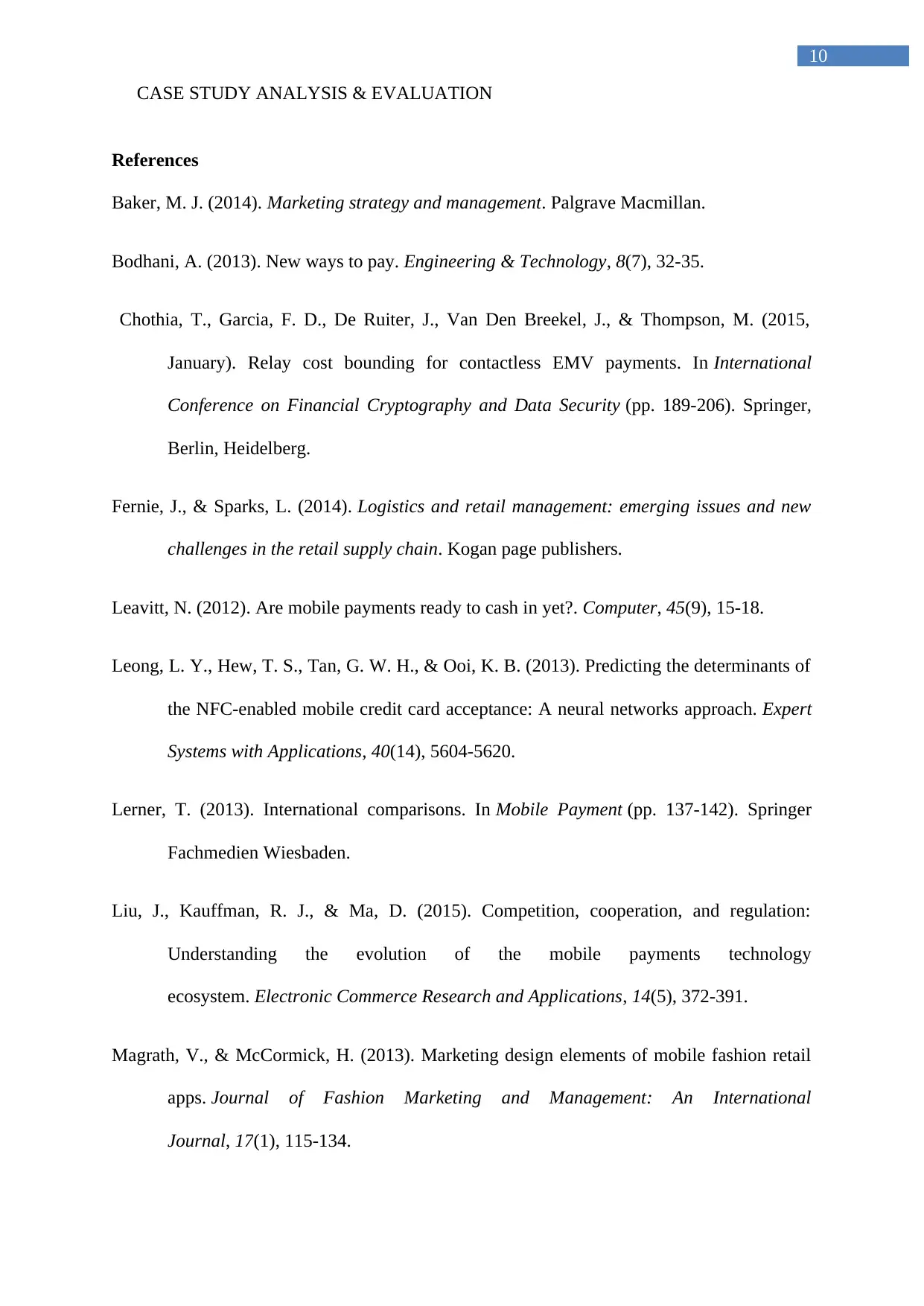
10
CASE STUDY ANALYSIS & EVALUATION
References
Baker, M. J. (2014). Marketing strategy and management. Palgrave Macmillan.
Bodhani, A. (2013). New ways to pay. Engineering & Technology, 8(7), 32-35.
Chothia, T., Garcia, F. D., De Ruiter, J., Van Den Breekel, J., & Thompson, M. (2015,
January). Relay cost bounding for contactless EMV payments. In International
Conference on Financial Cryptography and Data Security (pp. 189-206). Springer,
Berlin, Heidelberg.
Fernie, J., & Sparks, L. (2014). Logistics and retail management: emerging issues and new
challenges in the retail supply chain. Kogan page publishers.
Leavitt, N. (2012). Are mobile payments ready to cash in yet?. Computer, 45(9), 15-18.
Leong, L. Y., Hew, T. S., Tan, G. W. H., & Ooi, K. B. (2013). Predicting the determinants of
the NFC-enabled mobile credit card acceptance: A neural networks approach. Expert
Systems with Applications, 40(14), 5604-5620.
Lerner, T. (2013). International comparisons. In Mobile Payment (pp. 137-142). Springer
Fachmedien Wiesbaden.
Liu, J., Kauffman, R. J., & Ma, D. (2015). Competition, cooperation, and regulation:
Understanding the evolution of the mobile payments technology
ecosystem. Electronic Commerce Research and Applications, 14(5), 372-391.
Magrath, V., & McCormick, H. (2013). Marketing design elements of mobile fashion retail
apps. Journal of Fashion Marketing and Management: An International
Journal, 17(1), 115-134.
CASE STUDY ANALYSIS & EVALUATION
References
Baker, M. J. (2014). Marketing strategy and management. Palgrave Macmillan.
Bodhani, A. (2013). New ways to pay. Engineering & Technology, 8(7), 32-35.
Chothia, T., Garcia, F. D., De Ruiter, J., Van Den Breekel, J., & Thompson, M. (2015,
January). Relay cost bounding for contactless EMV payments. In International
Conference on Financial Cryptography and Data Security (pp. 189-206). Springer,
Berlin, Heidelberg.
Fernie, J., & Sparks, L. (2014). Logistics and retail management: emerging issues and new
challenges in the retail supply chain. Kogan page publishers.
Leavitt, N. (2012). Are mobile payments ready to cash in yet?. Computer, 45(9), 15-18.
Leong, L. Y., Hew, T. S., Tan, G. W. H., & Ooi, K. B. (2013). Predicting the determinants of
the NFC-enabled mobile credit card acceptance: A neural networks approach. Expert
Systems with Applications, 40(14), 5604-5620.
Lerner, T. (2013). International comparisons. In Mobile Payment (pp. 137-142). Springer
Fachmedien Wiesbaden.
Liu, J., Kauffman, R. J., & Ma, D. (2015). Competition, cooperation, and regulation:
Understanding the evolution of the mobile payments technology
ecosystem. Electronic Commerce Research and Applications, 14(5), 372-391.
Magrath, V., & McCormick, H. (2013). Marketing design elements of mobile fashion retail
apps. Journal of Fashion Marketing and Management: An International
Journal, 17(1), 115-134.
Paraphrase This Document
Need a fresh take? Get an instant paraphrase of this document with our AI Paraphraser
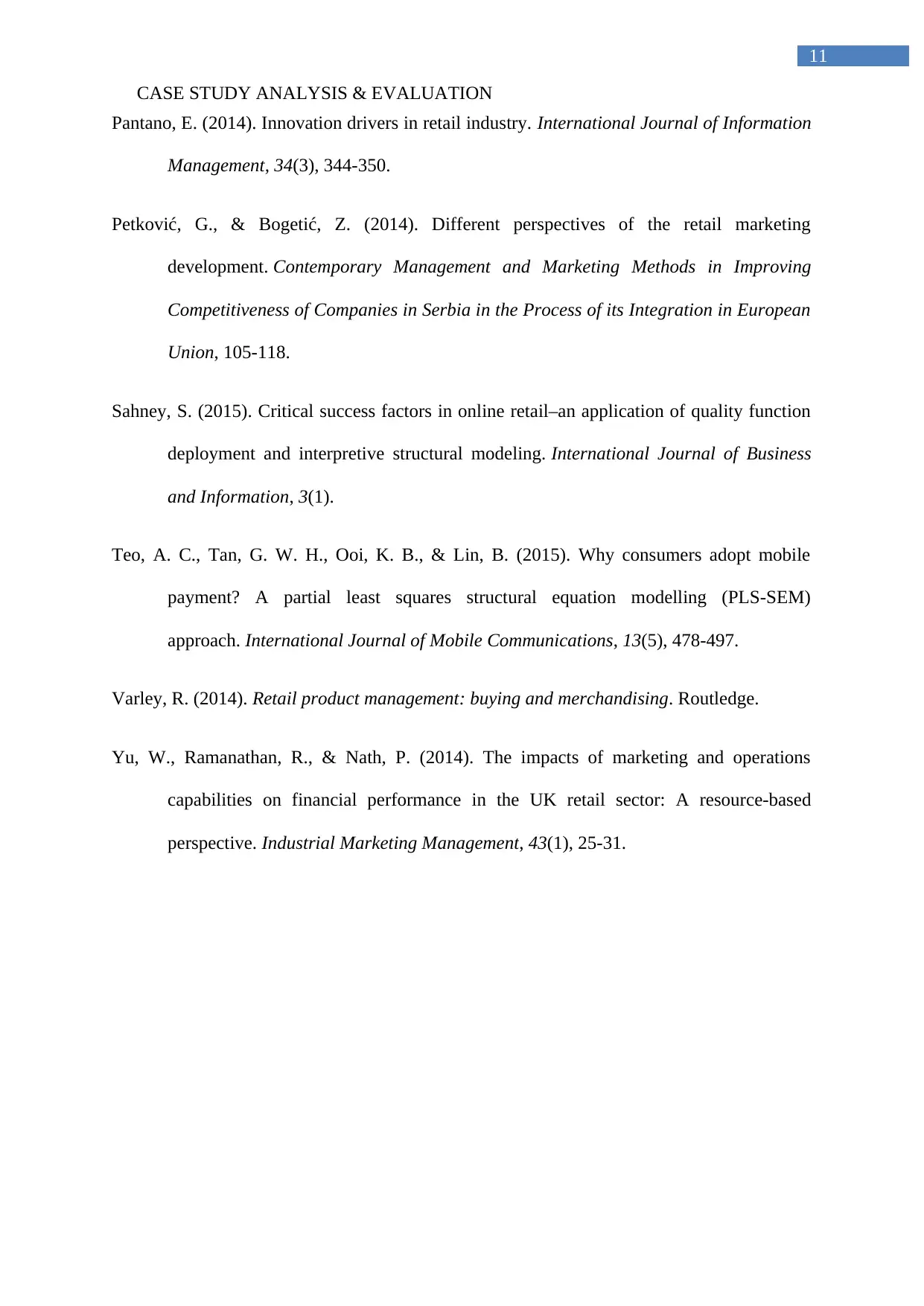
11
CASE STUDY ANALYSIS & EVALUATION
Pantano, E. (2014). Innovation drivers in retail industry. International Journal of Information
Management, 34(3), 344-350.
Petković, G., & Bogetić, Z. (2014). Different perspectives of the retail marketing
development. Contemporary Management and Marketing Methods in Improving
Competitiveness of Companies in Serbia in the Process of its Integration in European
Union, 105-118.
Sahney, S. (2015). Critical success factors in online retail–an application of quality function
deployment and interpretive structural modeling. International Journal of Business
and Information, 3(1).
Teo, A. C., Tan, G. W. H., Ooi, K. B., & Lin, B. (2015). Why consumers adopt mobile
payment? A partial least squares structural equation modelling (PLS-SEM)
approach. International Journal of Mobile Communications, 13(5), 478-497.
Varley, R. (2014). Retail product management: buying and merchandising. Routledge.
Yu, W., Ramanathan, R., & Nath, P. (2014). The impacts of marketing and operations
capabilities on financial performance in the UK retail sector: A resource-based
perspective. Industrial Marketing Management, 43(1), 25-31.
CASE STUDY ANALYSIS & EVALUATION
Pantano, E. (2014). Innovation drivers in retail industry. International Journal of Information
Management, 34(3), 344-350.
Petković, G., & Bogetić, Z. (2014). Different perspectives of the retail marketing
development. Contemporary Management and Marketing Methods in Improving
Competitiveness of Companies in Serbia in the Process of its Integration in European
Union, 105-118.
Sahney, S. (2015). Critical success factors in online retail–an application of quality function
deployment and interpretive structural modeling. International Journal of Business
and Information, 3(1).
Teo, A. C., Tan, G. W. H., Ooi, K. B., & Lin, B. (2015). Why consumers adopt mobile
payment? A partial least squares structural equation modelling (PLS-SEM)
approach. International Journal of Mobile Communications, 13(5), 478-497.
Varley, R. (2014). Retail product management: buying and merchandising. Routledge.
Yu, W., Ramanathan, R., & Nath, P. (2014). The impacts of marketing and operations
capabilities on financial performance in the UK retail sector: A resource-based
perspective. Industrial Marketing Management, 43(1), 25-31.
1 out of 11
Related Documents
Your All-in-One AI-Powered Toolkit for Academic Success.
+13062052269
info@desklib.com
Available 24*7 on WhatsApp / Email
![[object Object]](/_next/static/media/star-bottom.7253800d.svg)
Unlock your academic potential
Copyright © 2020–2025 A2Z Services. All Rights Reserved. Developed and managed by ZUCOL.





